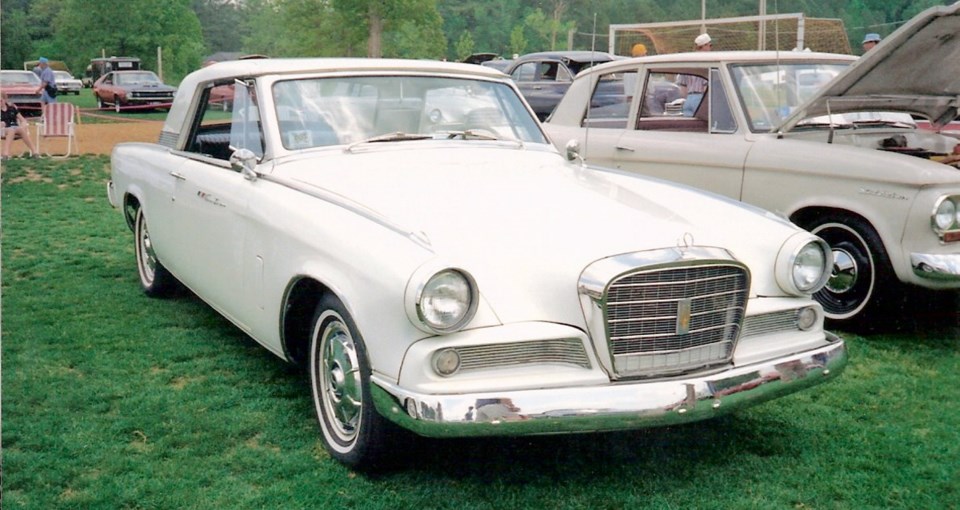The Studebaker coupes that bowed as the 1953 Starlight and Starliner models were among the handsomest American cars. Their graceful lines and low silhouettes penned in stylist Raymond Loewy’s studio inspired Road & Track to label them “The American Car with the European Look.” They evolved into the Hawk series in 1956.
But the coupes arrived as smaller automakers were suffering badly from competition. And several marques had disappeared during the 1930s Depression.
After the Second World War, the relentless onslaught of the Big Three (General Motors, Ford and Chrysler) was in the process of finishing the job. To survive, Studebaker merged with Packard in 1954 to become Studebaker-Packard Corp.
The evolutionary Hawk series was a bright spot for Studebaker. It arrived in 1956, and Hawks came in four series: Flight Hawk, Power Hawk, Sky Hawk and Golden Hawk. But by 1959, the novelty had worn off and it was down to just the Silver Hawk. Sales had slid from a high of 19,674 in 1957 to a dismal 3,929 in 1961.
The Hawk was no longer financially viable, and Studebaker Packard faced a decision: either drop it or rejuvenate it. President Sherwood Egbert chose rejuvenation and engaged noted industrial designer Brooks Steven of Milwaukee, Wisconsin, to work his magic.
An architect by training, Stevens’ portfolio included motorcycles, trains, tractors and even the Willys Jeepster. He might be best remembered for the Excalibur, a rather outlandish replica of a 1928 Mercedes-Benz.
Stevens wasn’t given much to work with. Studebaker could only afford $7 million to restyle both the Lark and Hawk, petty cash in the car business. In addition, Stevens had a short deadline because management wanted the revised model ready in a few months instead of the usual two to three years. In spite of these conditions, Stevens accepted the challenge.
Recognizing that the coupe’s basic lines would have to remain, he concentrated on the areas of least cost. Sheet-metal alterations were limited to new exterior door skins without the coupe’s sculpting. A new top was created with squared-up rear quarter panels reminiscent of the 1958 to 1960 Ford Thunderbird.
The grille surround bore a decided Mercedes-Benz influence (Studebaker-Packard was then M-B’s North American distributor) with a simple but tasteful mesh pattern grille. Mouldings extended the full length of the fender line ending in new taillamps echoing those of the 1961 Lincoln Continental.
Fender cutouts were accentuated by chrome mouldings connected by stainless-steel rocker panels. An inset rear window, formal roofline and rear “grille” with pattern matching the front one gave the car a distinctive following view. A new badge placement here and a chrome stripe there completed the job.
To accentuate its European flavour, the new Studebaker was named the Gran Turismo Hawk. It made its debut for 1962, and it was immediately evident that Stevens had wrought a minor miracle. With little time or money, he had converted the old Hawk into a crisp and appealing design that nicely concealed its ancestry.
The GT Hawk was well received by auto critics, who lauded it as a European-type, four-place grand-touring car. It had Studebaker’s overhead-valve 4.7-litre, 210 horsepower V-8 (225 with optional four-barrel carburetor).
Power went to the rear wheels through a standard three-speed manual transmission or threespeed automatic. To give it that additional continental flavour, a floor-shift manual four-speed and overdrive were available.
Performance was more than adequate. In May 1962, Car Life reported zero to 100 km/h in 11.4 seconds and top speed of 166 km/h with the four-speed, 225horsepower version.
The GT Hawk would benefit from even more power during its short life. In 1963, an optional belt-driven McCullough Paxton supercharger like the one on the Studebaker Avanti gave up to 290 horsepower.
The Gran Turismo Hawk was built until late in 1963, i.e., into the 1964 model year. At that point, Studebaker ceased production in South Bend, Indiana, and consolidated car building in its Hamilton, Ont., plant.
Despite its good reception, Studebaker sold only a disappointing 9,335 1962 Gran Turismos. The fact that Studebaker’s survival was in question no doubt cast a long shadow over sales. In three model years, just 15,736 Gran Turismo Hawks were produced, a small number compared with such competitors as the Ford Thunderbird and Buick Riviera.
It was, however, an excellent example of what a talented stylist could do with a good basic design, despite limited time and money. GTs are still fondly remembered by many former owners.



